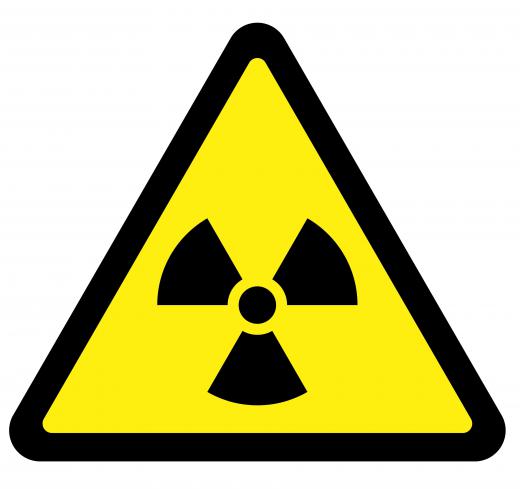What is Promethium?
 Mary McMahon
Mary McMahon
Promethium is an extremely radioactive chemical element classified among the rare earth metals on the periodic table. The element does not seem to appear naturally on earth, although it has been successfully created through artificial means. Promethium is also observed in the spectra of some stars, probably because of the nuclear reactions which occur in stars. Average consumers rarely interact with promethium, given its extreme rarity and highly specialized applications.
The appearance of promethium is a topic of discussion, since pure natural promethium has not been identified. It seems to have two allotropic forms, meaning that the structure of the element can vary in at least two ways when it is purified. In addition to being radioactive itself, promethium also produces a number of radioactive isotopes, some of which are very useful in various industries. On the periodic table of elements, promethium can be found under the symbol Pm, and it has an atomic number of 61, which places it among stable elements, which is rather unusual; most radioactive elements are grouped with other radioactive elements.

The existence of promethium was hypothesized as early as 1902, when chemists realized that there was a missing element between elements 60 and 62. Several attempts were made to isolate the missing element 61, but the credit for the discovery of promethium usually goes to J.A. Marinsky, L.E. Glendenin, and C.D. Coryell, who announced their discovery in 1947. The men had been doing research on uranium fission and neutron bombardment of neodymium at Oak Ridge National Laboratory in Tennessee, and in the course of their work, they found the new element at last.

The inspiration for the name of the element came from Coryell's wife, who said that the discovery of the element was like stealing fire from the Gods. In Greek mythology, Prometheus did just that, so the men named the element for him. Promethium isotopes are often used as radioactive tracers, and the element is also used to make gauges, various luminescent products, and in the phosphor industry.
Because promethium is radioactive, it is extremely dangerous and it should be handled with care. The element emits beta rays, which can create X-rays when they interact with heavier elements, posing dangers to people who work with promethium. Access to promethium is typically tightly controlled because of the radioactivity, and most people who work with it are given proper safety training, or they work in facilities which already have radiation protection protocols in place, like nuclear power plants.
AS FEATURED ON:
AS FEATURED ON:












Discussion Comments
what are the uses of promethium?
what are the physical properties of promethium?
Post your comments